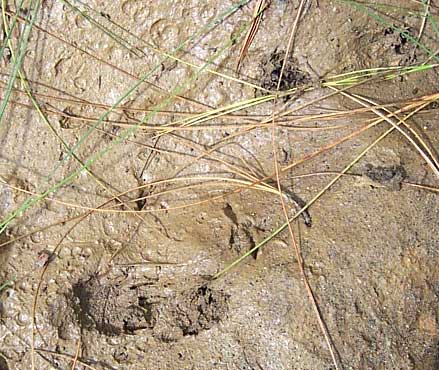Excerpts from Jim Conrad's
Naturalist Newsletter
from the November 19, 2007 Newsletter issued from Yerba Buena Clinic just outside Pueblo Nuevo Solistahuacan, Chiapas, MÉXICO
about 1740 meters in elevation, ± LAT. 17° 11' 27"N, LONG. -92° 53' 35"W
SKUNK TRACKS
I always check mud for tracks, such as those shown below:

In that picture you see fallen pine needles in the middle of which there's a bird footprint, then below to the left and above at the right are the tracks that got my attention. Here's how I diagnosed those:
First, these are really small tracks. The print at the lower left is only about the size of my thumbnail, so we have a rat-size animal.
The top-right shows prints of the animal's left feet while the bottom-left prints are of the animal's right feet. Keeping in mind that the trail travels from left to right, the animal's right-side feet are a fair distance from its left-side ones, so we have an animal that's fairly broad for its size, one that surely waddles as it walks. In terms of forward direction, the front tracks are fairly close to the back tracks, so we have a short creature with a short stride, not a long one who bounds from spot to spot like a weasel.
Even before analyzing the tracks I was thinking "skunk" because the lower, left print shows a broad, flat pad with five forward-pointing, sharply clawed toes. In North America the Striped Skunk prints I'm used to are larger than these, but they do have that broad pad and forward-pointing toes.
In upland Chiapas we also have Striped Skunks, as well as Hog-nosed and Spotted Skunks. Striped and Hog-nosed Skunks are "regular sized" but maybe you remember my encounter at Komchén in the Yucatan with a rat-sized Spotted Skunk who chased me down the road, the story at www.backyardnature.net/yucatan/spotsknk.htm.
That aggressive little critter also was encountered in mid November.
Therefore, I'm almost certain that the picture shows skunk prints, wouldn't be surprised if they belong to a Spotted Skunk, and I'd like to believe that the poor creature who left the print was a male wandering around in the evening in the same hormone-crazed, pathologically brash state of mind as that one back at Komchén.